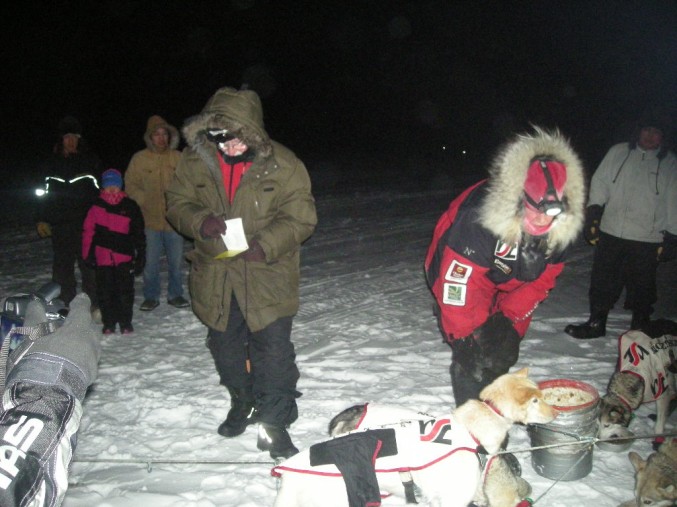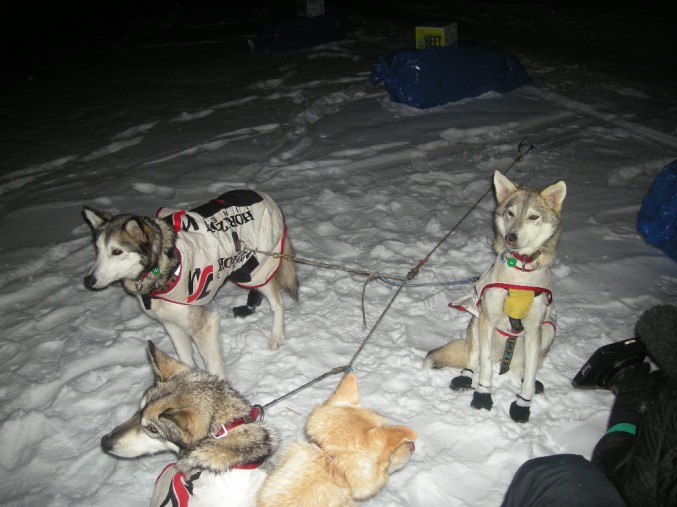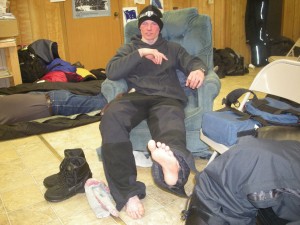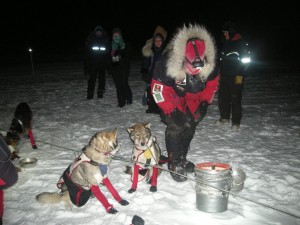Very Early a.m. reporting—–Aliy Zirkle in at 1:25AM, Ramey Smyth surges and now third into White Mountain by Joe Runyan
We are now in early a.m. reporting, after noting that Aliy Zirkle is now in at 1:25 AM. Her lead dogs Pocito and Dingle, impressively alert and crowd favorites, followed Aliy’s every move a s she distributed a thick wet ration of commercial kibble, followed by frozen slivers of meat snack.

Aliy consults with super vet Dr. Dean Bauman. Immediatel approachable, his team works closely with mushers
She is about one hour behind Dallas Seavey in the standings. Add eight hours and see that she is free to move in direction Nome at 9:25 a.m. She faces a challenge, not impossible, but formidable to catch Seavey.
Everyone notes the accomplished Dr. Dean Bauman and his crew working closely with mushers. “I see my job as an alliance for the well being of the dogs.” His style is based on communication, often seen with the mushers consulting. He is an approachable personality for all of us in the checkpoint, one of the reasons he is successful with his mushers.

Aliy's very cool leaders Pocito and Dingle, which I have hopelessly confused, but Dingle is the dog on the left of your photo
Ramey Smyth Just in as I write—-Ramey in at 2 17 am
In the meantime, the top ten has been shuffled. WE now find Ramey Smyth (last year 2nd place to John Baker) surging like a tsnami to third place. He will probably be about an hour behind Aliy tomorrow morning. Given his history as a powerful closer, and the way his team is presently moving, he could be a big headache, maybe a neck ache, for Aliy later today.
Ramey arrives very tired, naturally pleased to find himself in third place. Reports from the dog yard give high marks to the condition of the dogs.
While we are talking about upsets, I have apocryphal reports that Peter Kaiser, another young like Seavey, has passed Aaron Burmeister and could be in fourth place when the sun rises this AM. We will also be following Ray Redington, another musher with an ability to move ahead.
Why all the passing in the last 150 miles of the race?
A very good question, probably not well answered. However, one explanation is that some of our competitors—we think of John Baker, Aaron Burmeister, Mitch Seavey —designed a strategy to win. When all didn’t go their way, competitors were forced to back off and let their teams coast into the finish. Others, with a strategy aimed at finishing in the top ten, got exactly what they planned for on the coffee table.
The run to the finish in Nome— a few notes.
The Historical trail from White Mountain to Nome, if you are a musher, is replete with the tracks of early pioneers. And on this trail, calamity, even death is recorded. The winds on Top Kok Hill, a long upward climb that drops precipitously to the beach line of the Bering Sea , are notorious for killer winds. Locals have tried for over a hundred years to mark the trail for travelers caught in violent groundstorms and still are not entirely successful. Even iron tripods eventually fail and spruce pole tripods are regularly blown out to sea. Personally, I have been in groundstorms on Topkok hill and in one storm, turned around and waited for a better shot.
Once the musher drops onto the Bering sea beach, they can be confronted by howlers in well known blow holes where wind is funneled down coastal valleys like a venture. Winds can hit and commonly blow mushers and dogs off their feet, sending sled sideways. Generally, the winds at the quarter are a significant nuisance all the way to Nome.
22 miles from Nome the trail passes Safety, a sign in and out only checkpoint. Here, some mushers like Ramey Smyth, whistle up their dogs and can make astounding last minute passes into the finish.
To be passed in the last 22 miles, after nearly a thousand miles of struggle, is a brutal psychological blow, but it happens. Some, especially the mushers that specialize in passing, consider it character building to be passed.
Dallas hobbles in checkpoint—-blister on big toe bothersome!!!
In the checkpoint, Dallas Seavey lances a very bothersome blister on his left big toe. Looks painful as I see Dallas tenderly walking barefoot, following a vet assisted attention to the blister. He says he can run, but he’ll have it bandaged.

Dallas sore toe, almost too graphic for a close photo. It looks painful---too many hills, a few too many steps
Final Thoughts
A big gap of five hours separates our following mushers—-time for crews to take a nap. They will come alive again at 8:14 a.m. —Dallas may depart WM for Nome.


































